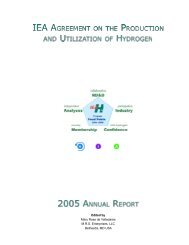Technology Status of Hydrogen Road Vehicles
Technology Status of Hydrogen Road Vehicles
Technology Status of Hydrogen Road Vehicles
You also want an ePaper? Increase the reach of your titles
YUMPU automatically turns print PDFs into web optimized ePapers that Google loves.
vehicles (as well as stationary) applications. The PEM FC has the additional advantages <strong>of</strong> low voltage<br />
degradation, good long-term stability, high power density, and favorable overload behavior. Besides, its lack<br />
<strong>of</strong> a corrosive liquid electrolyte gives an edge in safety and compactness; and it is fuel- and reactant-tolerant;<br />
i.e., it can accept, up to a point, CO contamination (even methanol) at the anode, and air at the cathode; in<br />
contrast, the A FC needs pure H 2 and O 2.<br />
Laboratory tests were carried out with pure H 2, and H 2 with 100 ppm CO as fuel; and with pure Pt, Pt 0.5Ru 0.5,<br />
and Pt 0.7Ru 0.3 as anode catalyst. The main results were:<br />
! Maximum power density with Pt 0.5Ru 0.5 higher than with pure Pt by a factor <strong>of</strong> 4<br />
! No significant difference in power density for pure H 2 or for H 2/100 ppm CO up to 0.4 A/cm 2 current<br />
density.<br />
The paper discusses some concepts for direct methanol PEM FC.<br />
Scherer, G.G., et al., “Materials Research Aspects <strong>of</strong> Membrane Development for Polymer Electrolyte<br />
Fuel Cells,” Paul Scherrer Institut, Villigen, Switzerland, pp. 1727-1736.<br />
In this work, the preparation <strong>of</strong> novel proton conducting membranes is described.<br />
A three-step process is involved: first, the base polymer is irradiated by a gamma or electron source to create<br />
radicals as reactive sites; second, a monomer or monomer/crosslinker mixture is grafted onto the activated<br />
polymer; third, the grafted film is sulfonated.<br />
Initial characterization tests are described in this complex materials problem.<br />
Friedrich, J.; K.E. Noreikat, “State <strong>of</strong> the Art and Development Trends for Fuel Cell <strong>Vehicles</strong>,”<br />
Daimler-Benz, Stuttgart, Germany, pp. 1757-1766.<br />
This paper starts with some important vehicle statistics and projections, and takes the FC car as one <strong>of</strong> the<br />
most interesting alternative drive concepts to meet future needs and satisfy environmental requirements.<br />
The present worldwide vehicle population amounts to some 500 million cars and 170 million commercial<br />
vehicles. With an annual increase <strong>of</strong> 17 million, the total becomes 1.6 billion in 2030. The total traffic-related<br />
CO 2 emissions on this basis goes from 4.4 billion tons in 1995 to 6.7 billion tons in 2030 (their Figure 1 gives<br />
the breakdown by four categories <strong>of</strong> vehicle, and separately by six regional blocs).<br />
The ICE and FC physically separate the energy converter from the energy storage; batteries do not.<br />
Vehicle drive systems should possess four equally important properties, interlinked and sensitive to one<br />
another: efficiency; power; transient response; range.<br />
The ICE has an efficiency drawback, but will probably dominate for the foreseeable future. A new drive<br />
system that can use the distribution system <strong>of</strong> conventional hydrocarbon fuels starts with an enormous<br />
advantage, so FC with methanol may be a natural successor.<br />
After examining 10 advantages <strong>of</strong> FC, and discussing the types <strong>of</strong> FC, the conclusions are reached that the<br />
PEM FC with H 2 fuel is most indicated for city buses and public service vehicles making use <strong>of</strong> centralized<br />
fueling and maintenance; the PEM FC with methanol reforming is most indicated for vans, minivans, and<br />
private cars.<br />
The Mercedes van <strong>of</strong> Item 9 Table 1 has been in operation for about 2 years, and is the fruit <strong>of</strong> a strategic<br />
66













